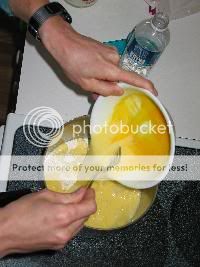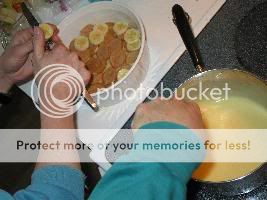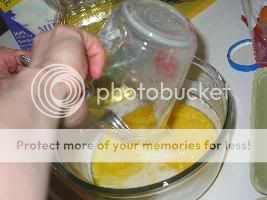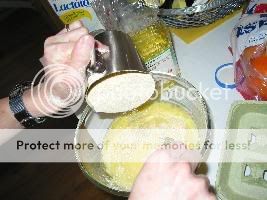
We've Been On Vacation
Though not the one I was thinking we would go on. When I started posting these weblogs, I had mentioned that we planned a long 2 week West trip but several factors interceded to make us change our minds. 1. We have a 23 month old baby who absolutely hates taking trips longer than 20 minutes in a car - she whines, bawls, screams without giving it up for up to 3 hours at a time before she will collapse from fatigue. 2. With the recent upsurge in gasoline prices, several hundred dollars would have been added on to an already costly trip if you take into consideration that those weeks I do not work amounts to so much loss in pay. 3. Taking long, self-indulgent, extravagant voyages do not fit appropriately into the simple lifestyle and is discordant with our changed (hopefully) outlook on our life.
So instead of driving out west toward the Dakotas to visit Roosevelt Natl Park in N.Dakota, we went instead to a place which ironically is an absolute den of affluenza - Myrtle Beach, SC. We did this because it is within a few hours drive from our house and we hoped to be able to stay there relatively conveniently and be "fun" for our 7 year-old and 2 year-old. Driving through I-95 you see one of the most dastardly self-evident tourist-traps on the East-coast:

When I was a kid back in the mid-1970s, my family stopped here and we purchased dozens of over-priced souvenir items for no good reason. My parents weren't doing it for comic effect or out of sardonic glee as many who frequent "Roadside Kitsch" do nowadays. They were simply naive and were honestly impressed with the roadside billboards set-up for hundreds of miles along I-95 proclaiming the importance of this monument - when we finally arrived, we all jumped out of our car to exult in this promised land of Kitsch. As Kitsch goes nationwide, South of the Border is unusually low-quality Kitsch - by this statement, I'm comparing SotB to other Hall-of-Fame Kitsch sites nationwide I've visited: The House On The Rock in Wisconsin (near Madison), Wall Drug in Wall, South Dakota and the Crazy-Horse monument in Western South Dakota, Niagara Falls area near Buffalo NY. Each site of Kitsch I've visited I can claim honestly I entered without the slightest clue that I was about to be bombarded by kitsch. I've been very naive about such things throughout my life and I came to realize that people throughout the world are prone to erect monuments to bad taste only after visiting dozens of such sites, all in good faith. Last year I discovered roadsideamerica.com and perusing this site, I decided to re-visit many of these sites again, this time with a more appreciative eye for kitsch. This was part of the reason for the grand Western trip I had planned, but decided that it really was a waste of time and effort, and would have been exhausting and obnoxious for my kids.
So we went for Myrtle Beach. Driving through Conway, the run-down little town attached to this tourist mecca, you can't help but notice how hopeless the South Carolina economy seems to be. They do attract the occasional large car-factories etc. but in general, this is a state which is unable to drum up any of its own business very well. The economically depressed, semi-rural, failing strip-mall towns dotting South Carolina is very typical of the deep South. You some of these in Eastern and Mountain-region North Carolina and Virginia also, but not nearly in the quantity you see in SC, TN, GA, AL, WVa, MS.

Once we were at the beach I'm afraid to say we indulged in the decadence of a "Resort hotel" - though I partially blame this on catering to my kids. The "resort hotel" however was not of the 4 diamond variety, but rather a seedy set-up along the raucous South Myrtle Beach streets (The Yachtsman Hotel). South Myrtle is a haven for teenagers and as such offer relatively cheaper lodgings. The strip along the "Grand Strand" is full of low rent stores such as tattoo and piercing parlors, bars, chintzy amusement parks, Ripley's believe it or not tourist traps, etc. We avoided all of these places and stayed around the beach and our hotel pool. One interesting thing - my son and I were just absent-mindedly putting together a modest sand castle using a couple of buckets and our hands - it may have taken us 30-40 minutes to do it and the product was rather mediocre, though a marvel for my 7-yr-old son. Well, within minutes this thing attracted several (5-6) groups of people passing by and they felt the need to gawk at it and compliment us as if it were one of those masterpieces you see produced by artists at beach festivals. It made me wonder if one were to sit down near Washington Square in NYC or at that Piazza San Marco in Venice and started drawing little childish stick figures whether you could attract a crowd to gawk at your (absence-of-)talent.

This is the actual thing that seemed to draw passersby.
The Special Forces Museum
On the way back from the beach we stopped by the dreadful city of Fayetteville NC where I spent a large part of my childhood. We did this because my wife and son wanted to see the Special Forces Museum which is located in the downtown area. I warned them that the Fayetteville area is not a great place for kids - and to bear me out, on our way out of the parking lot a Schizophrenic army vet bicycled up to us and frantically started showing us a stained & ripped piece of museum brochure. I reminded my wife again that Michael Jordan's dad was shot and killed near Fayetteville NC. In any case, the Special Forces Musuem was FREE and probably worth a visit, though strewn with much propaganda. The museum is large, very clean and well-set-up. Here's a close-up of a parachute frozen in deployment:

Here's a shot of the underside of an actual C47 in the Normandy, D-Day exhibit:

Genealogy

One of the other things my wife and I have been hooked-on recently is the idea of tracing one's genealogy the best you can. My wife's lines we thought would be relatively easy since her family on all four lines were all in North Carolina since the 1700s and many of their graves were nearby. It turns out nothing is very simple. When we visited the NC State Archives, we were disappointed to realize that once you go back to pre-1900s and before, all census data, marriage records, death records, land deeds, wills, etc. were written in long-hand, usually cursive, with a fountain-pen or quill-pen. In fact, even blown-up on microfilm, it can be very difficult to decipher with certainty what you are reading. It takes a lot of detective work and much corroborative and redundant pieces of evidence to convince yourself that something such as a birth or marriage date is an absolute fact. Many times the dates are off by a year, or by a day, purely by the vagaries of the person entering the data. It would turn out that some scribe re-copying information collected during a census would read "Sarah" written by an individual in the field as a "Mary" and confidently write it as such on the official records - exasperating. What we found to be the source of greatest certainty is often the family Bible. Here is a copy of my wife's maternal grandfather's:

It seems old folks used to write in birth, marriage, and death dates into the middle of these bibles on pages duly meant for such purposes. Again an ancestor's bad penmanship ruins any efforts at properly confirming these records also, but fortunately these were much more legible.
Besides communicating with many of the older members of the family, an exciting aspect of genealogy tracing is visiting old cemetaries. It takes a lot of good research to locate the place of burial of a long-lost ancestor - we were able to track several down by reading a newsletter written by one of my wife's great-aunts. It actually took a trip into a local (county) library where we thought the cemetary was located to ascertain the actual location.

This is the Randolph Library in Asheboro, NC.
We found that there were two churches with identical names located within 30 miles of each other, Tabernacle United Methodist Church - by happenstance, we had wasted an afternoon rooting through the wrong church cemetary. By looking through the cemetary rolls at the county library, we discovered that there are ladies who go around every 50 or so years or and read tombstones and record what they read - by looking through these readings, my wife finally located a cemetary where several of her direct ancestors were buried (not in Randolph, but in Guilford County, NC). Once we arrived, we were shocked to find the condition some of these 200+ year-old tombstones were in:


We were gratified to be able to read (via tracing on paper over the markings) some of them and confirming the birth/death dates we had researched from family bibles and state and county archive records. It turns out that doing "tombstone rubbings" is bad for the delicate old tombstones - there are better ways to read it using tangential lighting at night, or with water, etc. Here is an impressively well preserved tombstone of a great(5)grandfather of my wife who was born 1775:

His wife Hanna Fields buried next to him was grand-daughter of a Christopher Vickery who fought with George Washington in Valley Forge. It seemed like none of the tombstones much older than this, and many of the tombstones even a hundred years younger were easily legible. I guess limestone was used for some of the worst ones because it was cheaper than granite or marble. It looks like really tracing out one's genealogy and keeping up with all 4 grandparents lines with all the children in all branches will be a nearly lifelong endeavor. We'll be writing it into a genealogy software program and hopefully publish it onto our websites to share with family if we ever get on with it.





































